


Madisonville Site Information and Picture Gallery
I will be update and add to this area over time. Please check back for updates.
The Madisonville Site is located in Southwest Ohio on the East side of Cincinnati. It is located on an isthmus shaped ridge about 1/2 mile from the Little Miami River. The site was occupied roughly between the years of 1100-1670 A.D. Occupation was heaviest between 1400-1670. It is believed that occupation ended at the site with a series of Iroquois raids. This makes the site a late Fort Ancient - Protohistoric culture. The site is known to have contained over 1450 burials and 1300 cache pits. The number of artifacts discovered numbers close to one million.
Excavations at the Madisonville Site began in earnest after local resident and owner of the property Phoebe Ferris called attention to the site locally called "The Pottery Field" to Dr. Charles Metz. There is some evidence that locals were looking for artifacts at Madisonville as early as 1850. Metz formed the Madisonville Literary and Scientific Society and primitive excavations were conducted for almost 5 years. Soon, Harvard's Peabody Museum became interested and Frederick Putnam excavated the site from 1882-1911. During this period all Harvard trained archaeologist were required to complete a dig season at the site as a course of study. In 1891, excavations were carried out for the World Columbian Exposition. In 1895, the American Museum of Natural History in New York carried out an excavation. The most recent excavations were carried out by Kenneth Tankersley and Wes Cowan through the Cincinnati Museum of Natural History. In 2004, further work was conducted by the contract firm of Grey and Pape under archaeologist Matt Purtill. I was lucky enough to volunteer on the Wes Cowan dig in 1987 and the Grey and Pape dig in 2004.
Eminent Fort Ancient Archaeologist James Griffin considered Madisonville "the site" of the Fort Ancient culture in the East of the Mississippi River that influenced the Cumberland, eastern Tennessee and Northern Illinois Fort Ancient manifestations. His work has continued with his student Penelope Drooker, who has researched and written extensively on the Contact period of Madisonville.
Madisonville pottery has long been hailed as the finest of the Ohio Valley. William H. Wooten wrote that the Madisonville pottery "achieved more design uniqueness in their pottery than other Ohio Valley cultures in a treatise for the Smithsonian Museum.
Wes Cowan, of Antique Roadshow fame, considered Madisonville site "one of the 10 most important sites in eastern North America."
An alphabetical list of museums that house artifacts from the Madisonville site:
1)Albany Museum, South Africa
2) American Museum of Natural History, NYC
3)Beloit College, Wisconsin
4)Cincinnati Art Museum
5) Cincinnati Museum of Natural History
6)Field Museum, Chicago
7)Imperial Museum, Tokyo
8)Indiana University
9)Museum Beaux Arts, Switzerland
10)University of Michigan
11)Museum of Puerto Rico
12)Ohio Historical Society
13)Peabody Museum Harvard University
14)Pratt Museum Amherst University
15)Smithsonian Institution
16)Trocadero Museum Paris
17) Wanganui Museum New Zealand.
Many of the photos on this page are to be used only for personal enjoyment and: material copyright © 2000 President and Fellows of Harvard College, all rights reserved
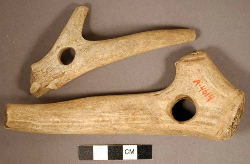
Antler Wrench:
Most likely used to straigten arrow shafts. Madisonville is unique, b/c it is the only site outside of a few paleo sites to have these tools. Use is only speculative.
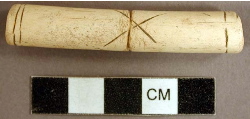
Engraved Tubular Bone Bead:
The Madisonville people used an "x" design on many of their artifacts. Clan symbol?
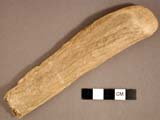
Antler Adze:
Adzes and gouges made from antler were found in quantity on the site
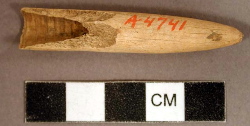
Socketed Antler Point:
Madisonville people were one the few people who drilled antler to form antler arrowheads. The damage to this piece nicely shows the tapered drilling.

Bone Beamer:
Leg bones were cut and used to deflesh hide. After use, they take an excellent polish.
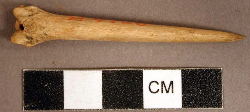
Bone Awl:
Bone awls were found in quantity at Madisonville. They were used for perforation, sewing and hair pins.
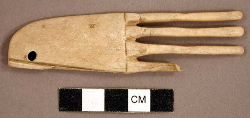
Bone Comb:
A very rare Fort Ancient artifact.

Bone Flute:
Many musical instruments were found at the site. These pieces are quite common on Fort Ancient sites.

Bone Rasp:
Another example of a musical/noise maker from the site.

Harpoon:
Madisonville harpoons are very similar to Alaskan pieces from the same time period. These pieces are exceedingly rare from Fort Ancient sites, but rather common at Madisonville.
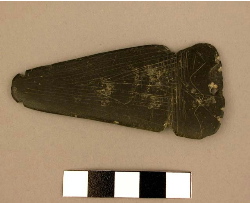
Cannal Coal Pendant:
Tallied and interesting form.
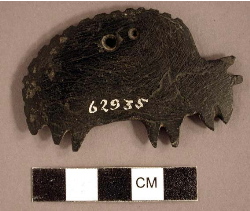
Cannal Coal Buffalo Effigy:
The Madisonville people were known to track buffalo along what is now Route 8 in Kentucky. Doctor Metz claimed to have found a trail that led from the Madisonville Site across the Ohio River and down to Big Bone lick. Cannal coal was often used for pendants at Madisonville.
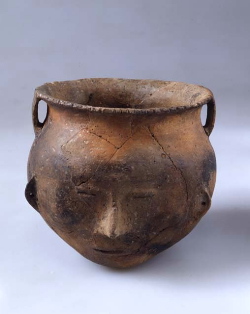
Human Face Effigy Pot:
This pot was dug by Metz. It was the very first piece donated and owned by the Cincinnati Art Museum when the museum came into existence. It is no longer on display and in storage gathering dust.
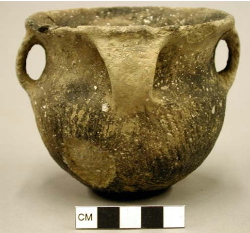
Strap Handled Pottery Vessel:
Shell tempered pottery vessel. According to James Griffin, 95% of all pottery found at Madisonville was strap handled. Thus, this example is very typical. As a child, I found the clay mine for the Madisonville site. It remains undocumented by scientists.

Antler Flaker:
These tools were used to finely flake flint objects
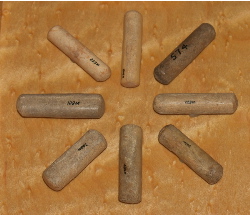
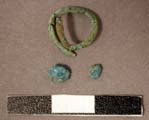
Copper and Trade Beads:
Some of the earliest evidence of European contact with the prehistoric people of Ohio. Written extensively about by Penelope Drooker.

Copper Trade Cross:
One of the few burial associations with Fort Ancient man and European trade items. A very important artifact.
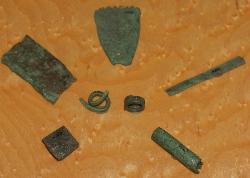
Copper Trade Items:
Madisonville is one of a handful of proto-historic sites in Southwest Ohio. These copper objects were traded into the site post-European contact. Notice the excellent fringed pendant.
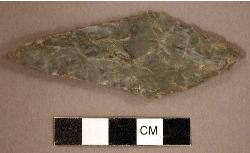
Large Bi-point Knife:
Madisonville is known for a large array of bi-points. This large example is one of the best.
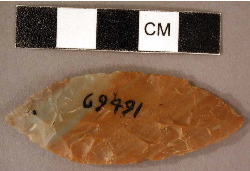
Carter Cave Bi-point Knife:
This one is made of excellent quality carter cave material and is typical of Madisonville flint knapping. Carter Cave is a majority material at the site even though the quarry site is located 150 river miles east.
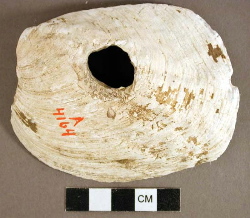
Unio Shell Ho:
Haft a stick down the perforation of this piece and you have a tool to till the grounds with. Common artifact on and around the Madisonville site.
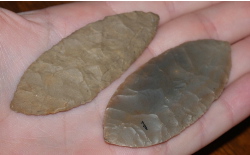
Two Bi-point Knives:
Two of the finer examples I have seen.

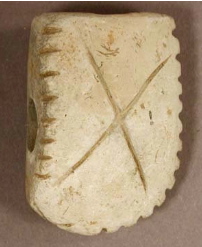
Pipe:
The "x" symbol is prominent on this piece.
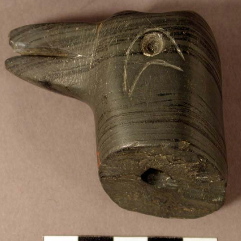
Banded Slate Pipe:
Weeping eye motif incised into piece. Piece looks to salvaged on the bottom. Is this a Fort Ancient "copy" of a birdstone effigy?
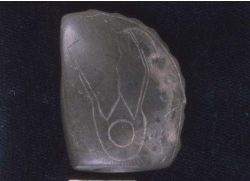
Weeping Eye Pipe:
Stylized weeping eye motif. Scholars believe the weeping eye is associated with the Southeastern Fort Ancient manisfestation. The symbol is common in Ohio and Madisonville.